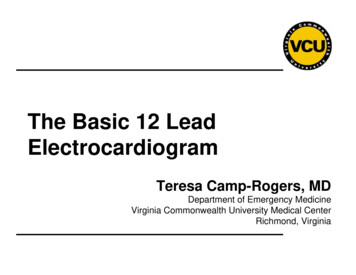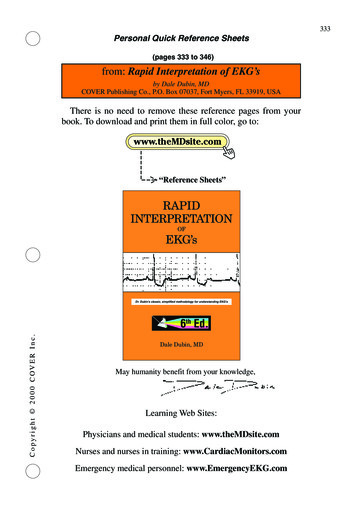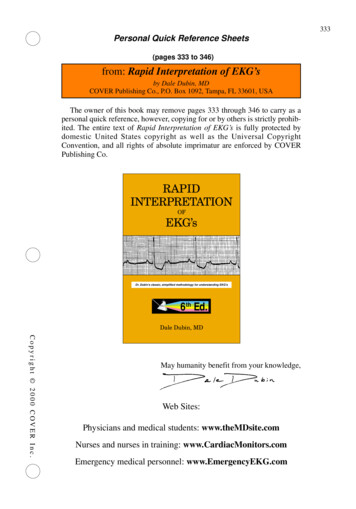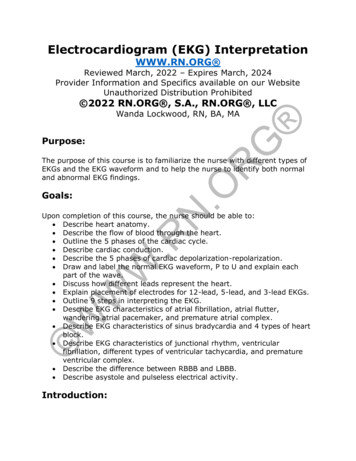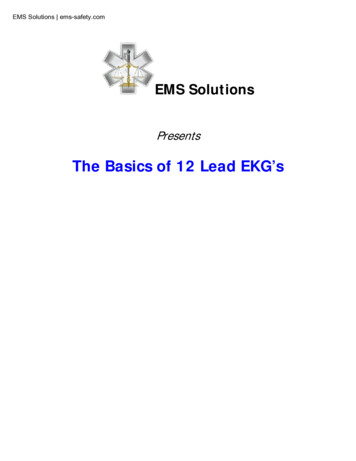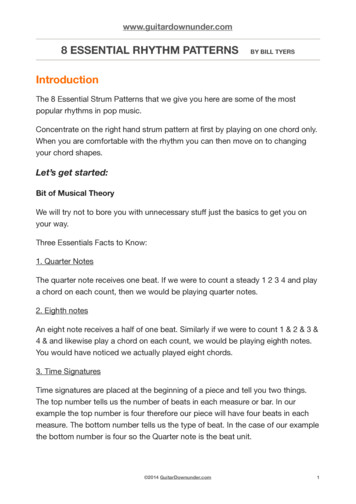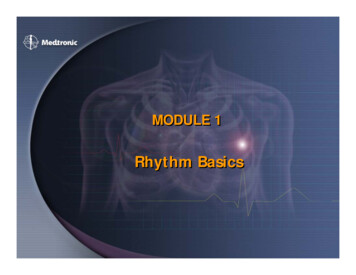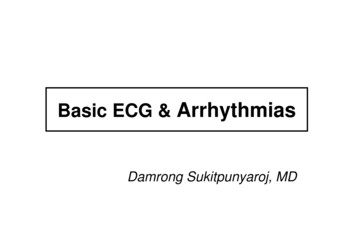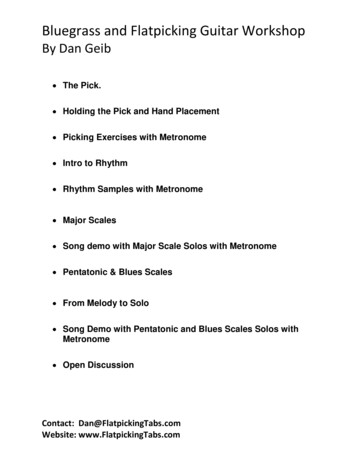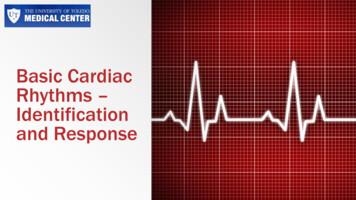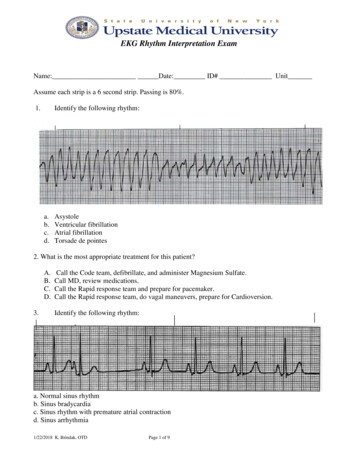
Transcription
asEKG Rhythm Interpretation ExamName: Date: ID# UnitAssume each strip is a 6 second strip. Passing is 80%.1.Identify the following rhythm:a.b.c.d.AsystoleVentricular fibrillationAtrial fibrillationTorsade de pointes2. What is the most appropriate treatment for this patient?A.B.C.D.3.Call the Code team, defibrillate, and administer Magnesium Sulfate.Call MD, review medications.Call the Rapid response team and prepare for pacemaker.Call the Rapid response team, do vagal maneuvers, prepare for Cardioversion.Identify the following rhythm:a. Normal sinus rhythmb. Sinus bradycardiac. Sinus rhythm with premature atrial contractiond. Sinus arrhythmia1/22/2018 K. Brindak, OTDPage 1 of 9
4.Identify the following rhythm:a.b.c.d.Atrial fibrillationSinus tachycardiaJunctional rhythmAtrial flutter5. What is this rhythm?a.b.c.d.6.Sinus tachycardiaNormal sinus rhythmSinus bradycardiaJunctional tachycardiaIdentify the following rhythma.b.c.d.Normal sinus rhythmSinus bradycardiaJunctional rhythmIdioventricular rhythm1/22/2018 K. Brindak, OTDPage 2 of 9
7.Identify the following rhythm:a.b.c.d.Normal sinus rhythmSinus rhythm with a premature junctional beatSinus arrhythmiaSinus rhythm with a premature atrial contraction8. What is the most appropriate treatment for this patient (from question#7)?A.B.C.D.9.Call the Rapid response team (if on telemetry), do vagal maneuvers.Call the Code team, defibrillate, and administer Magnesium Sulfate.Do nothing, this is a normal rhythm.Call the Code team, give atropine, prepare for pacemaker.Identify the following rhythm:a.b.c.d.Ventricular tachycardiaAsystoleAtrial fibrillationVentricular fibrillation10. The most appropriate treatment for this patient is:A. Nothing, this is a normal rhythm.B. Call the Code, defibrillate.C. Call the Rapid response team (on telemetry), attempt vagal maneuvers, Adenosine.1/22/2018 K. Brindak, OTDPage 3 of 9
D. Call the Rapid response team (telemetry), give Atropine.11.Identify the following rhythm:a. Mobitz Ib. Complete heart blockc. Mobitz IId. Idioventricular rhythm12. What is the most appropriate treatment for this rhythm?A. Call the rapid response team or code, prepare for pacemaker.B. Call the code, defibrillate patient.C. Administer Adenosine.D. Prepare for Cardioversion13.Identify the following rhythmA.B.C.D.Normal sinus rhythmSinus rhythm with premature atrial contractionVentricular bigeminyMobitz II1/22/2018 K. Brindak, OTDPage 4 of 9
14. Identify this rhythm:A.B.C.D.15.AsystoleSinus bradycardiaSinus rhythm with a pauseMobitz IIdentify the following rhythm:A.B.C.D.Atrial fibrillationSinus arrhythmiaAtrial flutterSinus rhythm with premature junctional beats16. This rhythm is a new onset rhythm for the patient. What is the best treatment?A. Assess pt, call MD, review medications, prepare for pacemaker.B. Assess, pt, call MD or Rapid response if hemodynamically unstable, review medications,prepare for possible Beta blocker, Ca channel blocker, Digoxin, cardioversion.C. Call code, defibrillateD. Call Rapid response team, prepare for atropine.1/22/2018 K. Brindak, OTDPage 5 of 9
17.Identify the following rhythm:A.B.C.D.18.Identify this rhythm:A.B.C.D.19.Sinus bradycardiaIdioventricular rhythmJunctional rhythmAccelerated ventricular rhythmJunctional rhythmSinus bradycardiaIdioventricular rhythmSinus rhythm with pausesYou walk in the patient’s room and is unable to arouse. He has no pulse and is not breathing.His monitor shows the following rhythm. Identify the rhythm:A.B.C.D.Normal sinus rhythmSinus BradycardiaPulseless Electrical ActivityFirst Degree Heart Block1/22/2018 K. Brindak, OTDPage 6 of 9
20. Identify this rhythmA.B.C.D.Ventricular tachycardiaSupraventricular tachycardiaAtrial fibrillationAccelerated junctional rhythm21. What is the best treatment for this patient?A. Assess pt, call MD, review medications, prepare for pacemaker.B. Assess, pt, call MD or Rapid response if hemodynamically unstable, review medications,prepare for possible Beta blocker, Ca channel blocker, Digoxin, cardioversion.C. Call code, defibrillate.D. Call Rapid response team, prepare for atropine.22. Identify this rhythmA.B.C.D.Ventricular fibrillationSinus tachycardiaVentricular tachycardiaSinus rhythm with PVCs1/22/2018 K. Brindak, OTDPage 7 of 9
23. Identify thisrhythmA.B.C.D.Normal sinus rhythmMobitz IFirst degree heart blockSinus bradycardia24. Identify this rhythm:A.B.C.D.Sinus tachycardiaAtrial flutterAccelerated junctional rhythmJunctional tachycardia25. Identify this rhythm1/22/2018 K. Brindak, OTDPage 8 of 9
A.B.C.D.Sinus rhythm with premature atrial contractionsMobitz ISinus rhythm with sinus arrestFirst degree heart block1/22/2018 K. Brindak, OTDPage 9 of 9
D. Call the Rapid response team (telemetry), give Atropine. 11. Identify the following rhythm: a. Mobitz I b. Complete heart block c. Mobitz II d. Idioventricular rhythm 12. What is the most appropriate treatment for this rhythm? A. Call the rapid response team or code, prepa
